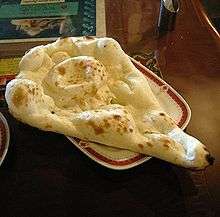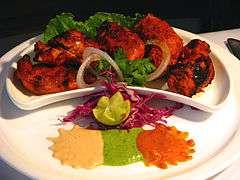Indian Chinese cuisine
 |
| This article is part of the series |
| Indian cuisine |
|---|
|
Regional cuisines
|
|
Ingredients, types of food |
|
See also
|
|
 |
| This article is part of the series |
| Chinese cuisine |
|---|
|
Regional cuisines
|
|
Ingredients and types of food |
|
|
Indian Chinese cuisine is the adaptation of Chinese seasoning and cooking techniques to Indian tastes through a larger offering of vegetarian dishes. The Indian Chinese cuisine is said to have been developed by the small Chinese community that has lived in Kolkata (formerly Calcutta) for over a century. Today, Chinese food is an integral part of the Indian culinary scene.[1] It is also enjoyed by Indian and Chinese communities in Malaysia, Singapore and North America.
Origins
The cuisine is believed to have originated from the Chinese of Kolkata and Chinese food is still popular there. At present, the Chinese population in Kolkata stands at approximately 2,000.[2] Most of these people are of Hakka origin; however, many dishes of modern Indian Chinese cuisine bear little resemblance to traditional Chinese cuisine.[3]
People of Chinese origin mostly live in India's only Chinatown located around Terreti Bazar and Bowbazar area, which has since been relocated to Tangra, Kolkata. Most of these immigrants were Hakka. Chinatown in Kolkata still boasts a number of Chinese restaurants specialising in Hakka cuisine and Indian Chinese variants.
Features
Foods tend to be flavoured with spices such as cumin, coriander seeds, and turmeric, which with a few regional exceptions, such as Xinjiang, are traditionally not associated with much of Chinese cuisine. Hot chilli, ginger, garlic, sesame seeds, dry red chilis, black pepper corns and yogurt are also frequently used in dishes.[4] This makes Indian Chinese food similar in taste to many ethnic dishes in Southeast Asian countries such as Singapore and Malaysia, which have strong Chinese and Indian cultural influences.
Non-staple dishes are by default served with generous helpings of gravy, although they can also be ordered "dry" or "without gravy". Culinary styles often seen in Indian Chinese fare include "Chilli" (implying batter-fried items cooked with pieces of chilli pepper), "Manchurian" (implying a sweet and salty brown sauce), and "Schezwan" (sic - see below) (implying a spicy red sauce). These correspond only loosely, if at all, with authentic Chinese food preparation.
Dishes
Main Course entrees
Ubiquitous main course entrees include:
- Chilli Chicken/Prawn/Fish/Mutton/Vegetables/Paneer
- Garlic Chicken/Prawn/Fish/Mutton/Vegetables/Paneer
- Schezwan (sic) Chicken/Prawn/Fish/Mutton/Vegetables/Paneer - dishes with this name in fact usually bear very little resemblance to ones from China's Sichuan Province (although they sometimes contain Sichuan peppercorns). They instead center mainly around a sauce containing Indian red chillies and garlic. (The spelling of "Schezwan" is not a mis-print; this is indeed the how the term tends to be spelled in the Indo-Chinese kitchen rather than "Sichuan", "Szechuan" or "Szechwan").[5]
- Ginger Chicken/Prawn/Fish/Mutton/Vegetables/Paneer
- Manchurian Chicken/Prawn/Fish/Mutton/Vegetables/Paneer, generally consisting of a variety of meats or paneer with vegetables in a spicy brown sauce.[6] It is basically a creation of Chinese restaurants in India, and bears little resemblance to traditional Manchu cuisine or Chinese cuisine.[3] It is said to have been invented in 1975 by Nelson Wang; Wang described his invention process as starting from the basic ingredients of an Indian dish, namely chopped garlic, ginger, and green chilis, but next, instead of adding garam masala, he put in soy sauce instead, followed by cornstarch and the chicken itself.[7] A popular vegetarian variant replaces chicken with cauliflower,[6] and is commonly known as gobi manchurian. Other vegetarian variants include mushroom, baby corn, veggie ball Manchurian.
- Chow mein A popular dish combining noodles, vegetables, scrambled egg, ginger and garlic, soy sauce, green chili sauce, red chili sauce and vinegar
- Hong Kong Chicken
- Jalfrezi Chicken
- Lemon Chicken/Prawn/Fish
- Hunan Chicken
- Sweet and Sour Chicken (Different from the American Version of Sweet and Sour, but similar to General Tso's Chicken)
- Chop suey American style & Chinese Style (Crispy Noodles with a variety of vegetables, chicken or meat and sauces.)
Often the nomenclature is such that the main ingredient is mentioned first, followed by the entree style such as "Chicken Chilli."
Rice and noodles
Staple base options for an Indian Chinese meal include chicken, shrimp or vegetable variants of "Hakka" or "Schezwan" noodles popularly referred to as chow mein; and regular or "Schezwan" fried rice. American chop suey and sweet and sour dishes can be found at many restaurants. Some South Indian restaurants have also come up with spring rolls and "Schezwan" dosas.
Unique dishes
- Gobi manchurian Fried cauliflower
- Chicken lollipop Chicken hors d'œuvre
- Manchow soup Vegetable/chicken soup
Sweets and Desserts
Indian Chinese dessert options include ice cream on honey-fried noodles or date pancakes.
Availability
Indian Chinese food is readily available in major metropolitan areas of India such as Bhopal, Surat, Vadodara, Rajkot, Mumbai, Pune, Chennai, Kochi, Guwahati, Hyderabad, Delhi, Lucknow, Kolkata and Bangalore. It is also available in a number of towns and at dhabas (roadside stalls), also popularly referred to as "Fast food", adjacent to major Indian roads and highways. Many restaurants have a Chinese section in their menus, and some are even dedicated to serving Indian Chinese food. It can also be found in mobile kitchen carts (lari or rekdi) that ply the streets of cities, prepared in woks over a portable gas burner. Manchurian sauce, Schezwan sauce, soy sauce and Hakka noodles are available in many stores in cities across the country.
Many overseas Indian restaurants in the West and the Middle East also cater to the overseas Indians' nostalgic taste for Indian Chinese food.[8] The cuisine is also branching out into the mainstream in major cities of North America such as New York City, San Francisco, Philadelphia, Chicago, Toronto, Los Angeles, Atlanta and Vancouver. Chinese food in Nairobi, Kenya, also tends to be of this style. It is also available in Australia, especially in Sydney and Melbourne. In many of these places, the restaurants are labelled as Hakka Chinese, when in fact the cuisine itself has very little resemblance to authentic Hakka cuisine. "Hakka" label in these restaurants are usually referring to the owner's origins, and many Chinese restaurant owners in India were of Hakka origin.
As of 2007, Chinese cuisine ranks India's most favorite cuisine (after local food), growing at 9% annually. It is the most favoured option when young people go out to eat and the second favorite (after south Indian cuisine) when families dine out.[9] Inchin's Bamboo Garden is the biggest Indian Chinese chain in America.
See also
References
- ↑ Sanjeev Kapoor (2007). Chinese Cooking ( Non-Veg). Popular Prakashan. p. 7. ISBN 978-81-7991-310-9.
- ↑ "The Chinese Of Calcutta". Catchcal.com. Retrieved 2009-02-22.
- 1 2 Mukherjee, Sipra; Gooptu, Sarvani, "The Chinese community of Calcutta", in Banerjee, Himadri, Calcutta Mosaic: Essays and Interviews on the Minority Communities of Calcutta, Anthem Press, pp. 131–142, ISBN 978-81-905835-5-8
- ↑ Deshpande, Shubada (October 25, 1999). "Fare for the Desi Dragon". Rediff.com. Retrieved 2009-02-22.
- ↑ Lee, Jennifer (April 30, 2013), "Authentic Indian "Schezwan" Dishes", The Fortune Cookie Chronicles
- 1 2 Thng, Lay Teen (2007-06-03), "Manchurian chicken", The Straits Times, retrieved 2010-04-21
- ↑ Bhagat, Rasheeda (2007-05-04), "Taste and disdain:A tour of the country's interesting eating habits with a roving journalist", The Hindu, retrieved 2010-04-21
- ↑ Chopra, Sonia (September 3, 2001). "Chinese food, Indian-style". Rediff.com (US Edition). Retrieved 2009-02-22.
- ↑ M, Raja (October 30, 2007). "India gets a taste for Chinese". Asia Times Online. Retrieved 2009-02-22.


